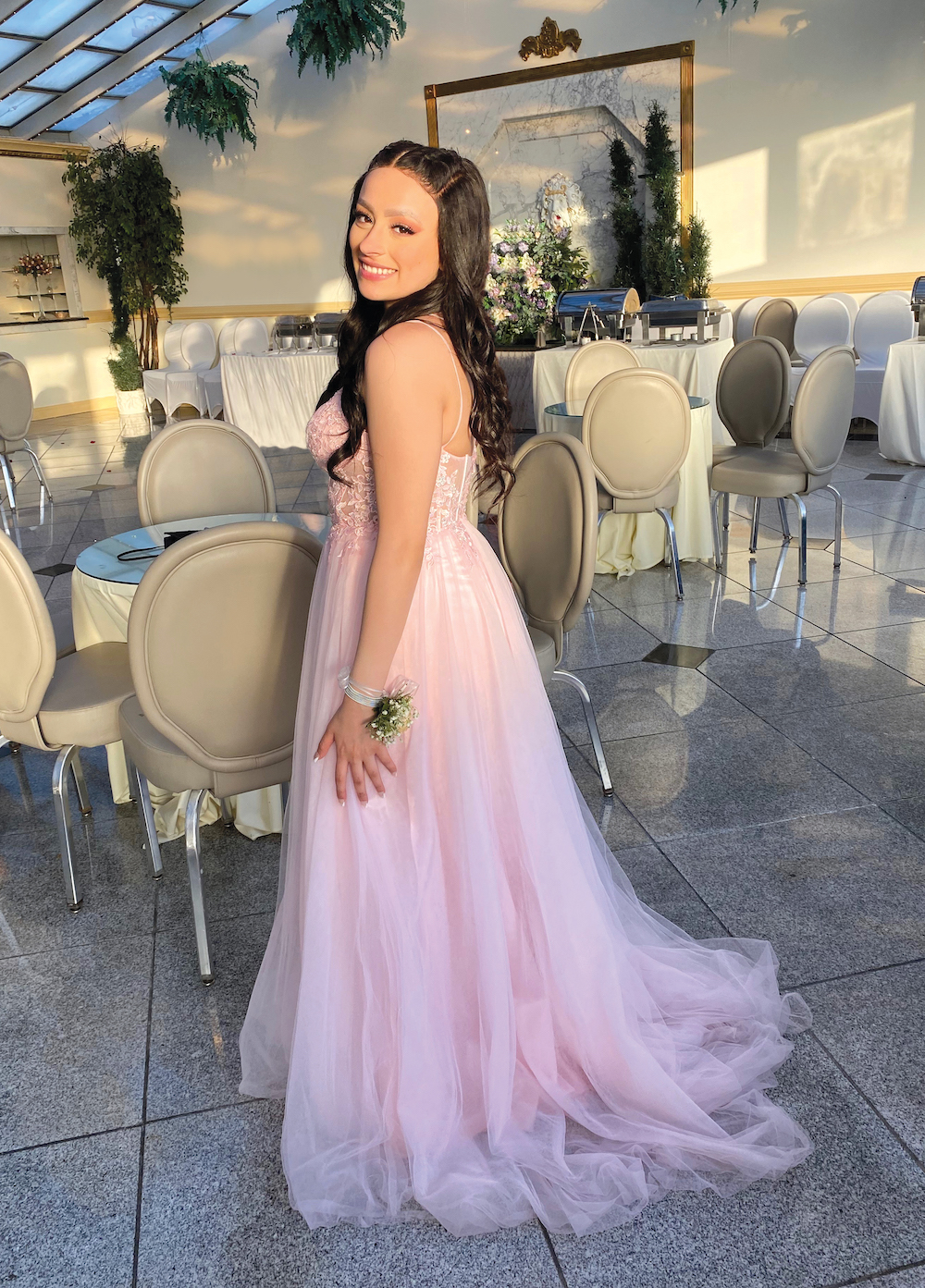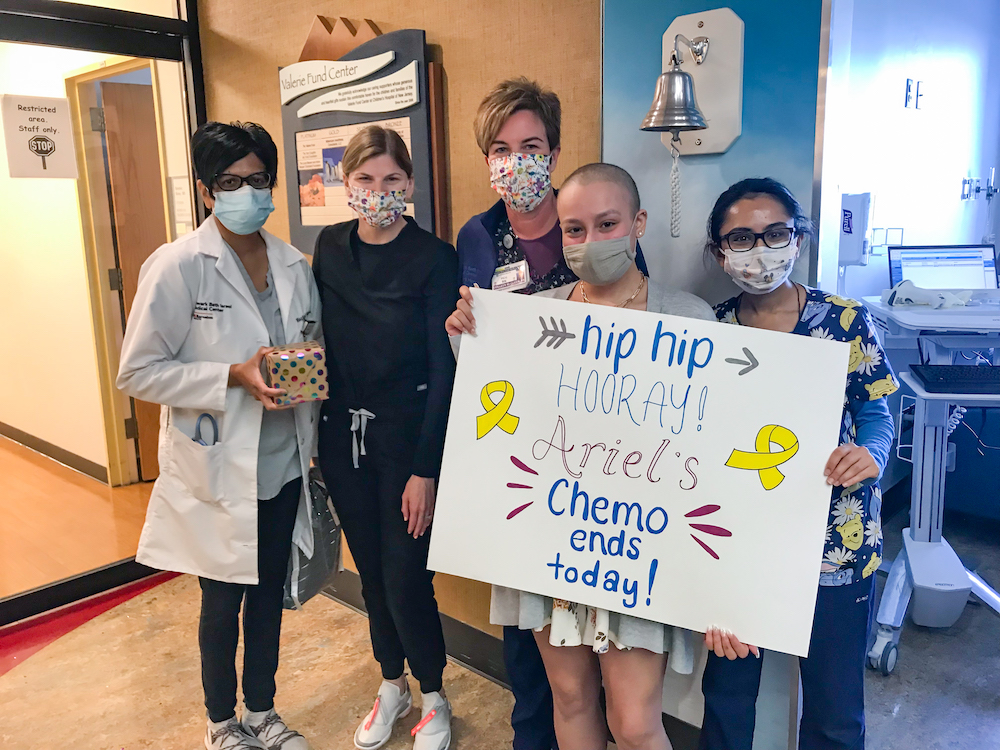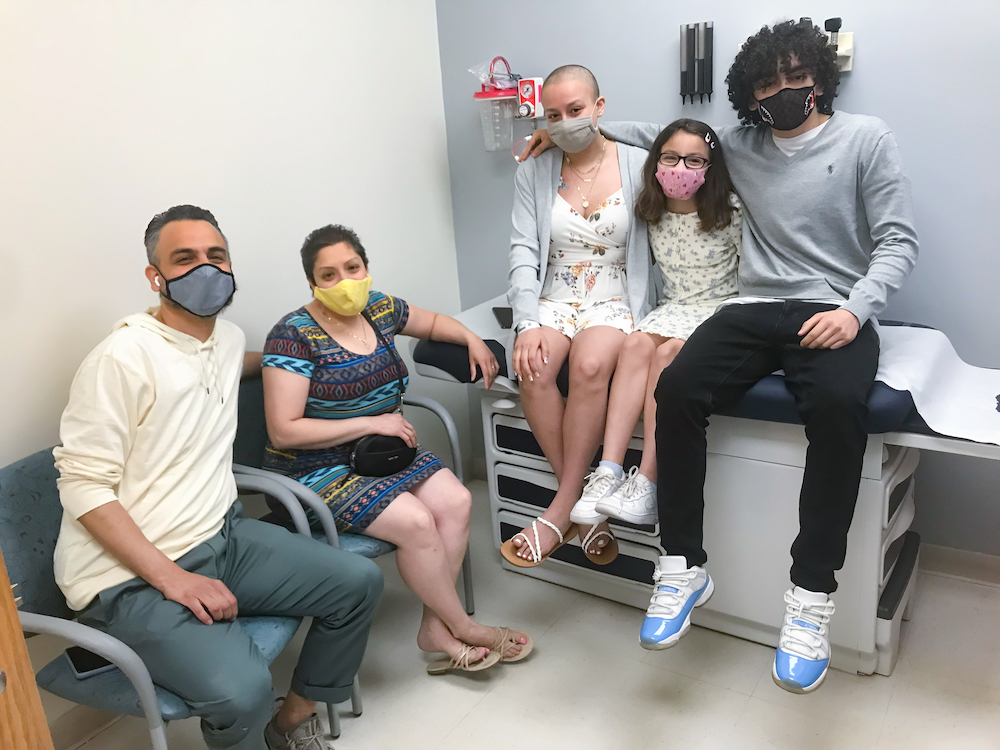Story by Mary Ann Littell View the complete magazine | Subscribe to Cancer Connection
Ariel Santos floated across the room, her pink tulle dress swirling. Her smile was radiant and her eyes shone. For this 17-year-old, prom night was more than just an evening of partying with friends. It was her very own victory dance.
For the past several months Ariel has battled Hodgkin lymphoma, a cancer most frequently diagnosed in people between 15 and 30 years of age and those over 55. Smart and beautiful, she has dreams of going to college and working in security, maybe for the FBI. Thanks to the care provided by experts at Rutgers Cancer Institute of New Jersey and Children’s Hospital of New Jersey (CHoNJ) at Newark Beth Israel Medical Center, her dreams can come true.
Ariel’s senior year should’ve been a time of excitement and anticipation, but it was quite the opposite. First came COVID, and Ariel and her two younger siblings hunkered down to virtual schooling in the family’s Secaucus home. “As we’re going through this pandemic, we learn Ariel has cancer,” says her mother, Ingrid Santos. “It’s been rough. But she got through it, thanks to her wonderful doctors.”
One of those doctors, radiation oncologist Rahul Parikh, MD, medical director, Laurie Proton Therapy Center at Robert Wood Johnson University Hospital and radiation oncologist at Rutgers Cancer Institute of New Jersey, cared for Ariel in her final stage of treatment, administering proton therapy, an advanced form of radiation therapy that’s a game-changer for pediatric patients with cancer. The Laurie Proton Therapy Center is the state’s only hospital-based proton therapy center in New Jersey.
“Our primary task was to get rid of Ariel’s cancer, and we were successful,” explains Dr. Parikh. He pauses for a moment and smiles. “But we had another goal: to finish her treatments before the prom. We met that goal too. Not only that, she had absolutely no negative effects from the proton therapy. So, mission accomplished.”
When Ariel first noticed a lump in her groin in November 2020, she didn’t want to think it was anything serious. It wasn’t sore or painful, just uncomfortable. By the time she showed it to her mother it was the size of a tennis ball.
%20suit%202015%20DVogel_0.jpeg)
All the treatment Ariel Santos needed was provided by teams at Rutgers Cancer Institute and RWJBarnabas Health. Radiation oncologist Rahul Parikh, MD (above left), medical director, Laurie Proton Therapy Center at Robert Wood Johnson University Hospital, and radiation oncologist at Rutgers Cancer Institute of New Jersey, and Harini Rao, MD (above right), at the Valerie Fund Children’s Center for Cancer and Blood Disorders at CHoNJ would lead her care.
“It was late and I was getting ready for bed,” recalls Ingrid. “I could see this lump through her pajama pants. I was alarmed, but tried not to show it.” She wondered if the lump’s sudden appearance was related to Ariel’s recent weight loss. She’d lost several pounds, though she hadn’t been dieting.
Ariel saw her pediatrician the next day. She thought the lump was probably benign and referred Ariel to a surgeon at Newark Beth Israel Medical Center, an RWJBarnabas Health facility, to see if it could be removed. The surgeon examined Ariel and sent her for imaging studies. A few days later he told Ingrid her daughter needed to see an oncologist. He’d made an appointment for the next day with Harini Rao, MD, at Valerie Fund Children’s Center for Cancer and Blood Disorders at CHoNJ.
Until now, the word cancer had not been part of the Santos family’s vocabulary. “I’m embarrassed to say I didn’t even know what an oncologist was,” Ingrid admits. “When I looked it up, I was like, ‘Oh, my goodness.’ My husband tried to reassure me, saying it was probably part of their protocol, to make sure it was nothing serious.”
When Ariel and Ingrid met Dr. Rao, they were impressed by her compassion and thoroughness. “She checked Ariel from head to toe, asked a million questions, did bloodwork and all kinds of tests, including a biopsy,” says. Ingrid. “I tried to keep Ariel calm, saying everything would be okay.”
With the holidays arriving, the family struggled to put cancer out of their minds. But as Ingrid drove to her parents’ home in the Bronx with Ariel just before New Year’s Eve, Dr. Rao called. Ingrid sent Ariel into her grandparents’ house and remained in the car.
The test results indicated Ariel had early-stage Hodgkin lymphoma, localized in the left inguinal area and involving some of the nearby lymph nodes. “Dr. Rao explained the treatment process,” says Ingrid. “I was devastated, but I put on a brave face so I wouldn’t upset Ariel and my mother.”
After the call, Ingrid entered her parents’ house as if nothing was wrong. That evening, she and her husband decided not to say anything yet. Ariel had her senior photos coming up and her parents wanted her to enjoy that special moment.
After Ariel’s photo session, the couple sat her down and broke the news. “She didn’t know what Hodgkin lymphoma was,” says her mom. “When we told her, she broke down crying. We told her she was going to be fine, but she’d have to go through a long rough patch.”
Hodgkin disease accounts for 16 percent of cancers diagnosed in adolescents in the U.S. It is highly curable, particularly when diagnosed early, like Ariel’s was. All the treatment this teenager needed would be provided by teams at Rutgers Cancer Institute and RWJBarnabas Health. Drs. Rao and Parikh would lead her care.
“While Dr. Rao and I work in different locations, we’ve collaborated and shared patients for years,” explains Dr. Parikh. “We have a regular pediatric hematology/oncology video conference where we brainstorm about cases and develop treatment plans. This multidisciplinary tumor board includes surgeons, oncologists, radiation oncologists, and other specialists from across the RWJBarnabas Health system: colleagues at Rutgers Cancer Institute, Robert Wood Johnson University Hospital, and Newark Beth Israel Medical Center.
“Discussing Ariel’s case, it was pretty clear what her treatment would be,” Parikh continues. “The standard therapy for early-stage Hodgkin lymphoma is combined modality therapy: first, chemotherapy, followed by PET scans to evaluate the response. If it’s favorable, you move on to radiation therapy. That usually leads to the best outcomes.”
Hodgkin disease accounts for 16 percent of cancers diagnosed in adolescent in the U.S. It is highly curable, particularly when diagnosed early, as was the case with Ariel Santos (above, second from right) along with her care team celebrating her last day of treatment at the Valerie Fund Children’s Center at Children’s Hospital of New Jersey at Newark Beth Israel Medical Center. From left: Harini Rao, MD; Autumn Banta, LCSW; Colleen McQueen, RN; and Rosh Patel, RN.
In mid-January Ariel began her treatment: three days of chemotherapy at CHoNJ: three days of chemotherapy in the hospital every 21 days. “She had a rough time with nausea and vomiting,” says her mom. “This girl had a patch behind her ear, she was on three different medications, but nothing helped with the throwing up. Sometimes she’d have to stay in the hospital for another day to recover.”
At home after the second round of treatment, Ariel felt dizzy while taking a shower. Ingrid called the hospital’s emergency number and was told to bring her daughter in. Ariel’s long hair was wet, so she twisted it into a bun. Hours later they returned home, and Ariel tried to take her hair down, to no avail. “Her hair was stuck in that bun,” says Ingrid. “She could not get it out. As we tried to help, her hair fell out in chunks. I said, as gently as I could, ‘Honey, I think we have to cut it.’ But she said no, she wasn’t ready to lose her hair.”
Grabbing a pair of scissors, Ingrid chopped off her own hair. “I handed her the scissors and said, ‘Now it’s your turn,’” says Ingrid. “We were laughing and crying. So that’s how we both ended up bald.”
Through the treatments, Ariel diligently focused on virtual school, no matter how sick she felt. Taking the few classes she needed to graduate, she met with her teachers on weekly FaceTime calls. “If she wasn’t feeling well, they postponed,” says Ingrid. “They were wonderful and sympathetic. They helped Ariel stay on track to graduate.”
Ariel had an outstanding response to chemotherapy. On May 27 she began a course of 14 proton therapy treatments, five days a week, at the Laurie Proton Center at Robert Wood Johnson University Hospital in New Brunswick. It is the only proton center in the state that is part of a National Cancer Institute (NCI)-designated cancer center. “We recognize that proton therapy is absolutely necessary for pediatric patients with cancer,” says Parikh, who is also an associate professor of radiation oncology at Rutgers Robert Wood Johnson Medical School. “We are very experienced in treating these patients.”
As active members of the Children’s Oncology Group, Parikh and many of his colleagues are studying ways to improve cure rates. “Our faculty members are at the forefront of the current clinical trials for Hodgkin lymphoma,” he says. “They’ve led many studies suggesting that patients do better when they receive proton therapy, rather than standard radiation.”
The benefit of proton therapy is that it is precisely controlled. Physicians can target the proton beam directly to the tumor area. The beam emits all its radiation in the tumor location without scattering through the body, protecting the surrounding healthy tissue.
“A patient like Ariel has reached her adult height, but she’s still a teenager, and her organs are still developing,” says Parikh. “With proton therapy we can spare those organs in her pelvis: her ovaries, bowel, rectum, and bladder.”
As Ariel Santos went through her treatments, she gained strength and support from her biggest cheerleaders – her family (above). “Ariel is not thinking about cancer anymore,” says her mom (above second from left). “She’s excited to start her studies and go for her goals.”
True to Parikh’s promise, Ariel felt no side effects from the proton therapy. She finished the treatments in under three weeks and went to her prom the next day. Thanks to a talented hairdresser, no one would have guessed she’d lost her hair to chemotherapy. A few days later she attended her high school awards ceremony and received a scholarship. The money will be put to good use as she heads off to college.
“Ariel is not thinking about cancer anymore,” says her mom. “She’s excited to start her studies and go for her goals.”
“Ariel has an excellent prognosis,” says Parikh. “Early-stage Hodgkin lymphoma, if staged and treated appropriately, rarely recurs. So she should remain cured for decades.”
He continues: “It’s a prime example of why you get the best care at an NCI-designated center. You’ll get not only the best chemotherapy, target therapy, immunotherapy, and all the best targeted options, but also state-of-the-art radiation options like proton therapy. Those are just some of the benefits of being treated at our health system and our cancer center.”
On a Mission
 Aiding in the longtime mission to increase investment in cancer research, Governor Phil Murphy recently signed the fiscal year 2022 state budget, which included a $10 million appropriation to support pediatric cancer research. This legislation, which was sponsored by Senate President Stephen M. Sweeney and Senator Anthony M. Bucco, will support the establishment of the Pediatric Cancer Center at Rutgers Cancer Institute of New Jersey, which in partnership with RWJBarnabas Health, is a leader in pediatric cancer research and care.
Aiding in the longtime mission to increase investment in cancer research, Governor Phil Murphy recently signed the fiscal year 2022 state budget, which included a $10 million appropriation to support pediatric cancer research. This legislation, which was sponsored by Senate President Stephen M. Sweeney and Senator Anthony M. Bucco, will support the establishment of the Pediatric Cancer Center at Rutgers Cancer Institute of New Jersey, which in partnership with RWJBarnabas Health, is a leader in pediatric cancer research and care.
Currently, fewer than five percent of federal funding for cancer research is dedicated specifically to understanding and seeking cures for pediatric cancer, and only two drugs targeting childhood cancer have been approved in the past 20 years according to the American Cancer Society. While cancer survival rates for children have improved significantly over the past 50 years, cancer remains the leading cause of death from disease among children.
The funding was championed by Grace Eline, a 12-year old survivor of brain cancer and childhood cancer awareness advocate who was treated at Rutgers Cancer Institute and Newark Beth Israel Medical Center, and her mother Aubrey Eline in collaboration with the American Childhood Cancer Organization. ■





